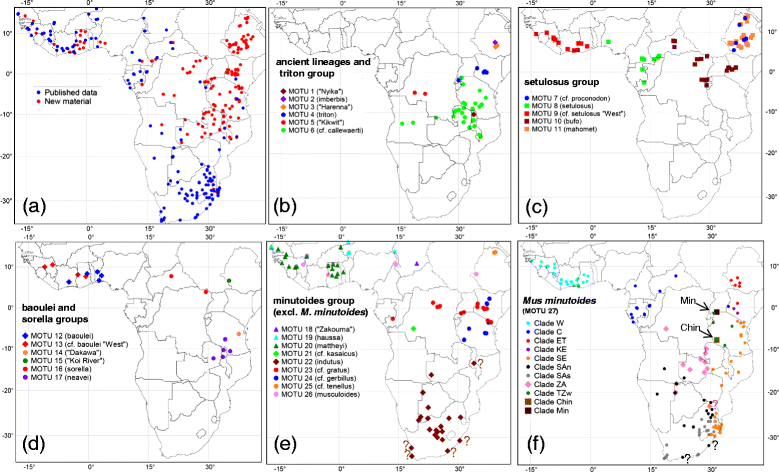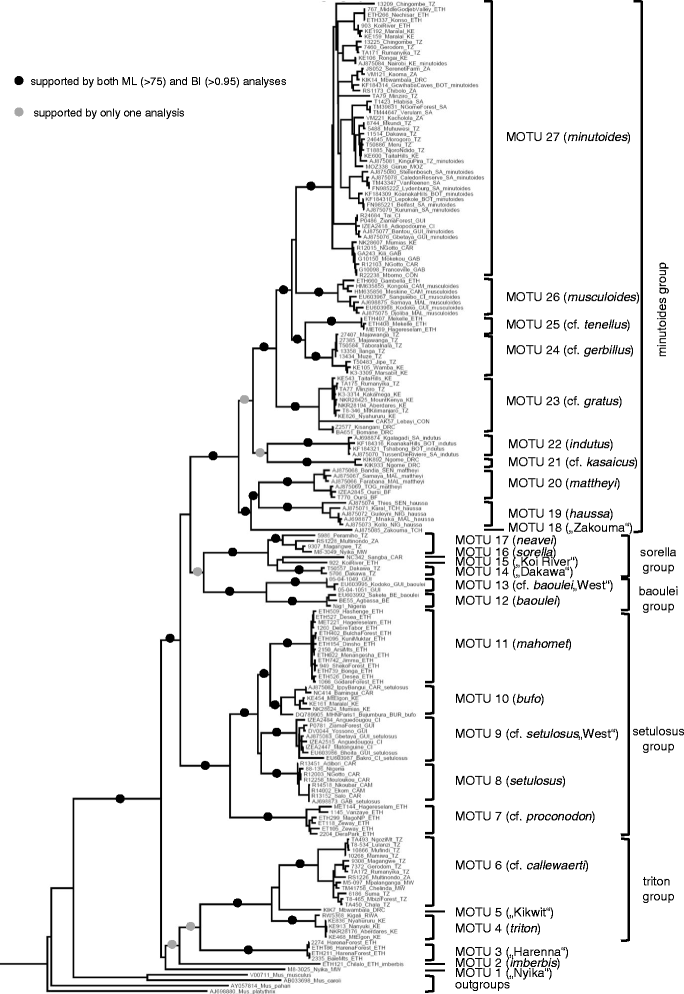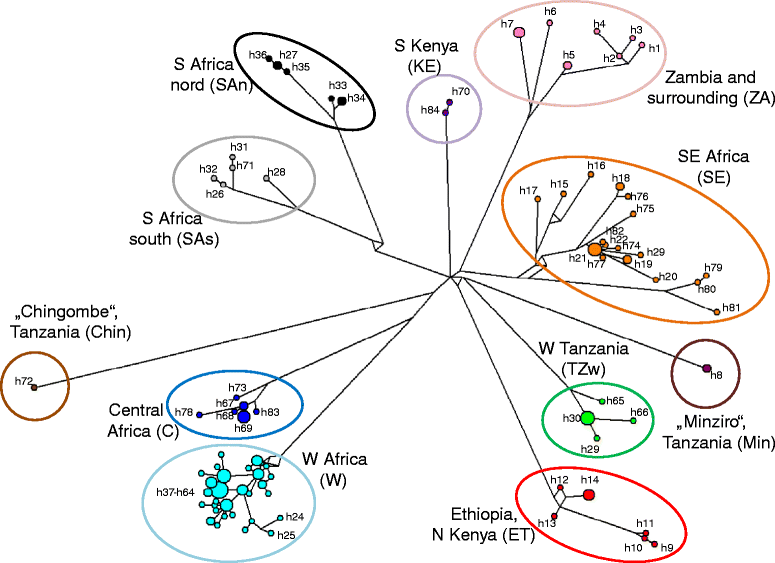Pan-African phylogeny of Mus (subgenus Nannomys) reveals one of the most successful mammal radiations in Africa
- PMID: 25496476
- PMCID: PMC4280006
- DOI: 10.1186/s12862-014-0256-2
Pan-African phylogeny of Mus (subgenus Nannomys) reveals one of the most successful mammal radiations in Africa
Abstract
Background: Rodents of the genus Mus represent one of the most valuable biological models for biomedical and evolutionary research. Out of the four currently recognized subgenera, Nannomys (African pygmy mice, including the smallest rodents in the world) comprises the only original African lineage. Species of this subgenus became important models for the study of sex determination in mammals and they are also hosts of potentially dangerous pathogens. Nannomys ancestors colonized Africa from Asia at the end of Miocene and Eastern Africa should be considered as the place of their first radiation. In sharp contrast with this fact and despite the biological importance of Nannomys, the specimens from Eastern Africa were obviously under-represented in previous studies and the phylogenetic and distributional patterns were thus incomplete.
Results: We performed comprehensive genetic analysis of 657 individuals of Nannomys collected at approximately 300 localities across the whole sub-Saharan Africa. Phylogenetic reconstructions based on mitochondrial (CYTB) and nuclear (IRBP) genes identified five species groups and three monotypic ancestral lineages. We provide evidence for important cryptic diversity and we defined and mapped the distribution of 27 molecular operational taxonomic units (MOTUs) that may correspond to presumable species. Biogeographical reconstructions based on data spanning all of Africa modified the previous evolutionary scenarios. First divergences occurred in Eastern African mountains soon after the colonization of the continent and the remnants of these old divergences still occur there, represented by long basal branches of M. (previously Muriculus) imberbis and two undescribed species from Ethiopia and Malawi. The radiation in drier lowland habitats associated with the decrease of body size is much younger, occurred mainly in a single lineage (called the minutoides group, and especially within the species M. minutoides), and was probably linked to aridification and climatic fluctuations in middle Pliocene/Pleistocene.
Conclusions: We discovered very high cryptic diversity in African pygmy mice making the genus Mus one of the richest genera of African mammals. Our taxon sampling allowed reliable phylogenetic and biogeographic reconstructions that (together with detailed distributional data of individual MOTUs) provide a solid basis for further evolutionary, ecological and epidemiological studies of this important group of rodents.
Figures




Similar articles
-
Multiple radiations of spiny mice (Rodentia: Acomys) in dry open habitats of Afro-Arabia: evidence from a multi-locus phylogeny.BMC Evol Biol. 2019 Mar 4;19(1):69. doi: 10.1186/s12862-019-1380-9. BMC Evol Biol. 2019. PMID: 30832573 Free PMC article.
-
A phylogeographic survey of the pygmy mouse Mus minutoides in South Africa: taxonomic and karyotypic inference from cytochrome b sequences of museum specimens.PLoS One. 2014 Jun 6;9(6):e98499. doi: 10.1371/journal.pone.0098499. eCollection 2014. PLoS One. 2014. PMID: 24905736 Free PMC article.
-
Molecular phylogeny of the African pygmy mice, subgenus Nannomys (Rodentia, Murinae, Mus): implications for chromosomal evolution.Mol Phylogenet Evol. 2005 Aug;36(2):358-69. doi: 10.1016/j.ympev.2005.02.011. Epub 2005 Mar 23. Mol Phylogenet Evol. 2005. PMID: 15955515
-
Phylogenomics of African radiation of Praomyini (Muridae: Murinae) rodents: First fully resolved phylogeny, evolutionary history and delimitation of extant genera.Mol Phylogenet Evol. 2021 Oct;163:107263. doi: 10.1016/j.ympev.2021.107263. Epub 2021 Jul 14. Mol Phylogenet Evol. 2021. PMID: 34273505 Review.
-
Cryptic diversity of Crocidura shrews in the savannahs of Eastern and Southern Africa.Mol Phylogenet Evol. 2023 Mar;180:107708. doi: 10.1016/j.ympev.2023.107708. Epub 2023 Jan 16. Mol Phylogenet Evol. 2023. PMID: 36657626 Review.
Cited by
-
Ectoparasite Fauna of Rodents and Shrews with Their Spatial, Temporal, and Dispersal along a Degradation Gradient in Mabira Central Forest Reserve.J Parasitol Res. 2023 Oct 28;2023:7074041. doi: 10.1155/2023/7074041. eCollection 2023. J Parasitol Res. 2023. PMID: 37928436 Free PMC article.
-
Tectonics, climate and the diversification of the tropical African terrestrial flora and fauna.Biol Rev Camb Philos Soc. 2021 Feb;96(1):16-51. doi: 10.1111/brv.12644. Epub 2020 Sep 13. Biol Rev Camb Philos Soc. 2021. PMID: 32924323 Free PMC article.
-
Establishment of African pygmy mouse induced pluripotent stem cells using defined doxycycline inducible transcription factors.Sci Rep. 2024 Feb 8;14(1):3204. doi: 10.1038/s41598-024-53687-9. Sci Rep. 2024. PMID: 38331995 Free PMC article.
-
Historical biogeography, systematics, and integrative taxonomy of the non-Ethiopian speckled pelage brush-furred rats (Lophuromys flavopunctatus group).BMC Ecol Evol. 2021 May 19;21(1):89. doi: 10.1186/s12862-021-01813-w. BMC Ecol Evol. 2021. PMID: 34011264 Free PMC article.
-
Multiple radiations of spiny mice (Rodentia: Acomys) in dry open habitats of Afro-Arabia: evidence from a multi-locus phylogeny.BMC Evol Biol. 2019 Mar 4;19(1):69. doi: 10.1186/s12862-019-1380-9. BMC Evol Biol. 2019. PMID: 30832573 Free PMC article.
References
-
- Zachos FE, Apollonio M, Bärmann EV, Festa-Bianchet M, Göhlich U, Habel JC, Haring E, Kruckenhauser L, Lovari S, McDevitt AD, Pertoldi C, Rössner GE, Sánchez-Villagra MR, Scandura M, Suchentrunk F. Species inflation and taxonomic artefacts - A critical comment on recent trends in mammalian classification. Mamm Biol. 2013;78:1–6.
-
- Groves CP. The nature of species: A rejoinder to Zachos et al. Mamm Biol. 2013;78:7–9.
-
- Krishna Krishnamurthy P, Francis RA. A critical review on the utility of DNA barcoding in biodiversity conservation. Biodivers Conserv. 2012;21:1907–1919. doi: 10.1007/s10531-012-0306-2. - DOI
-
- Hoffmann M, Grubb P, Groves CP, Hutterer R, Van der Straeten E, Simmons N, Bergmans W. A synthesis of African and western Indian Ocean Island mammal taxa (Class: Mammalia) described between 1988 and 2008: an update to Allen (1939) and Ansell (1989) Zootaxa. 2009;2205:1–36.
Publication types
MeSH terms
LinkOut - more resources
Full Text Sources
Other Literature Sources

